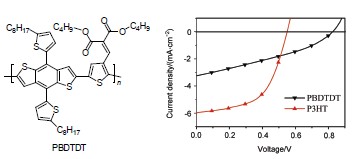| [1] Chu, T.; Lu, J.; Beaupré, S.; Zhang, Y.; Pouliot, J.; Wakim, S.; Zhou, J.; Leclerc, M.; Li, Z.; Ding, J.; Tao, Y. J. Am. Chem. Soc. 2011, 133, 4250.[2] Li, W.; Roelofs, W. S. C.; Wienk, M. M.; Janssen, R. A. J. J. Am. Chem. Soc. 2012, 134, 13787.[3] Hou, J.; Chen, H.; Zhang, S.; Chen, R. I.; Yang, Y.; Wu, Y.; Li, G. J. Am. Chem. Soc. 2009, 131, 15586.[4] Peng, Q.; Huang, Q.; Hou, X.; Chang, P.; Xu, J.; Deng, S. Chem. Commun. 2012, 48, 11452.[5] Burkhart, B.; Khlyabich, P. P.; Thompson, B. C. Macromolecules 2012, 45, 3740.[6] He, Y.; Chen, H.; Hou, J.; Li, Y. J. Am. Chem. Soc. 2010, 132, 1377.[7] Zhang, M.; Guo, X.; Li, Y. Macromolecules 2011, 44, 8798.[8] Huo, L.; Ye, L.; Wu, Y.; Li, Z.; Guo, X.; Zhang, M.; Zhang, S.; Hou, J. Macromolecules 2012, 45, 6923.[9] Saadeh, H. A.; Lu, L.; He, F.; Bullock, J. E.; Wang, W.; Carsten, B.; Yu, L. ACS Macro Lett. 2012, 1, 361.[10] Chen, J., Cao, Y. Acc. Chem. Res. 2009, 42, 1709.[11] Qin, R.; Li, W.; Li, C.; Du, C.; Veit, C.; Schleiermacher, H.; Andersson, M.; Bo, Z.; Liu, Z.; Inganäs, O.; Wuerfel, U.; Zhang, F. J. Am. Chem. Soc. 2009, 131, 14612.[12] Hong, Y.; Wong, H.; Moh, L.; Tan, H. Chem. Commun. 2011, 47, 4920.[13] Wang, B.; Tsang, S.; Zhang, W.; Tao, Y. Chem. Commun. 2011, 47, 9471.[14] Jiang, Z.; Zhang, W.; Yao, H.; Yang, C., Cao, Y.; Qin, J.; Yu, G.; Liu, Y. J. Polym. Sci. Part A: Polym. Chem. 2009, 47, 3651.[15] Wang, A. Chin. J. Mater. Res. 2012, 26(3), 327 (in Chinese). (王爱芬, 材料研究学报, 2012, 26(3), 327.)[16] Cai, W.; Gong, X.; Cao, Y. Solar Energy Mater. Solar Cells 2010, 94, 114.[17] Wang, E.; Ma, Z.; Zhang, Z.; Henriksson, P.; Inganäs, O.; Zhang, F.; Andersson, M. R. Chem. Commun. 2011, 47, 4908.[18] Du, C.; Li, C.; Li, W.; Chen, X.; Bo, Z.; Veit, C.; Ma, Z.; Wuerfel, U.; Zhu, H.; Hu, W.; Zhang, F. Macromolecules 2011, 44, 7617.[19] Zhang, Y.; Murphy, C. B.; Jones, W. E.; Jr. Macromolecules 2002, 35, 630.[20] Qu, S.; Qin, C.; Islam, A.; Wu, Y.; Zhu, W.; Hua, J.; Tian, H.; Han, L. Chem. Commun. 2012, 48, 6972.[21] Huo, L.; Zhang, S.; Guo, X.; Xu, F.; Li, Y.; Hou, J. Angew. Chem., Int. Ed. 2011, 50, 9697. |
